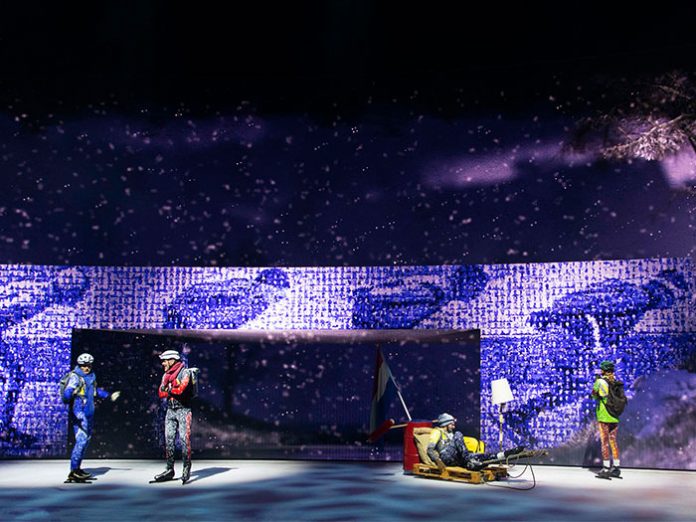De Tocht was directed by Eddy Habbema and choreographed by Marc Forno, Production Design was created by Luc Peumans, artistic director of Painting with Light (PWL), whose brief encompassed lighting, video and scenography, an ambitious collage of visual disciplines to capture all the skating action presented.
Peumans utilised over 200 Robe moving lights for the show including 120 ESPRITES, 83 LEDBeam 350s, 16 T2 Profiles and 13 iFORTES running on a remote follow spot system, supplied to the production by RentAll.
Peumans worked closely with Set Designer, Jo Segers. He had started discussing the show around five years ago with figure skater Madelène Van Beuzekom, the show was postponed twice due to Covid before finally being premiered in October this year.
The staging featured a 60m-wide by six metre-deep bespoke revolving ice track weighing 140 tons, offering up 2000 square metres of ice. The ice revolve was built by creative engineering specialist, Mannen van Staal from Leeuwarden and a seating tribune sits in the middle of this staging concept.
The stage is at one end of the venue, with a 52m-wide by 7.2-metre-high LED screen in front which splits open in four sections that track horizontally to reveal the stage behind. These sections move into different configurations to support the action happening on the revolve.
At the back of the stage is another screen, this one measuring 41 metres wide and eight metres high, so with the front screen open and two sections flanking each side of the stage, the total screen area spans a 93 metres. This presents an 18000-pixel wide vista for the audience and delivers the digital scenery and backdrops that the PWL team has devised for the project.
Peumans utilise all the Robe elements and the ESPRITES in particular where the front half of the revolve is all performance space while the 180 degrees behind the seating tribune comprises backstage and technical areas.
While the show design was originally planned to have projections – the newest ‘dark black’ screens were not yet available in 2018 – so it was decided to go with LED screens supplied by Faber Audiovisuals.
Peumans then found himself needing more lighting for projection onto the ice, which also led to his choice, the ESPRITE. The lights are rigged on a series of curved and straight trusses installed in the roof above the seating tribune and over the stage and ice.
As well as projecting onto the ice, with the addition of four custom gobos designed by PWL, the ESPRITES add texturing to the ice to make it appear more natural and match effortlessly with the video content. These fixtures also double up as front, top and back light. “They are used in a proper multifunctional context,” noted Peumans.
They are paired with the LEDBeam 350s, four side ladders each side of the stage provide boom positions, which are rigged with more LEDBeam 350s and T2 Profiles. Each boom ladder has two T2s and a pair of LEDBeam 350s plus a smoke machine and fan to boost the atmosphere.
With just shy of 400 luminaires in the main lighting rig and the large quantities of LED, key lighting and follow spotting were critical, so he chose to work with 13 Robe iFORTE FollowSpots rigged above the seating tribune, operated via a remote hybrid manual / automated system. Thirty-five other fixtures were also connected to the following system which is triggered either automatically via trackers worn by the cast or undertaken manually by two remote operators.
The key light tracking positional information is also used to mask the video content in the disguise gx 2c media servers, allowing the digital content to move in unison with the skaters staying in perspective.
Crisp key lighting further enabled Luc and the video content team led by Menno Broere to add more cinematic touches to the content with blur and bokeh. Lighting was programmed on a grandMA3 console by PWL’s Stijn Vanholzaets and Matthijs van Hulsentop during the technical and rehearsal sessions.
Vanholzaets was dealing with the main show lighting while Matthijs programmed the remote spotting system. Niels Huybrechts was the associate LD. The media servers were programmed by Toon Raskin, and the remote follow system was maintained by Rik van de Weerthof.
Peumans and the PWL team used the 18 months before to engage in preparation as they arrived on site organised. Working on all visual aspects of the production brought the huge bonus of being able to see digital content immediately.
“There was a lot of teamwork involved both internally and externally and it was great to collaborate as always – it’s the best way to work!” stated Peumans. “I think we all enjoyed being a] part of staging such a groundbreaking and entertaining performance which our audiences are loving!”






